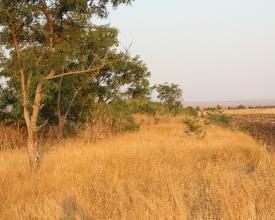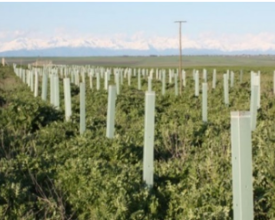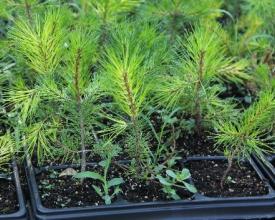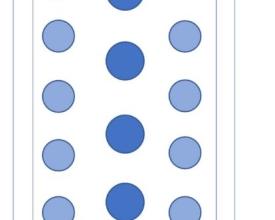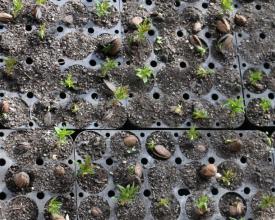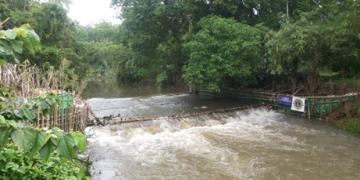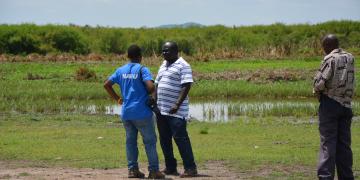
Rehabilitation of Windbreaks
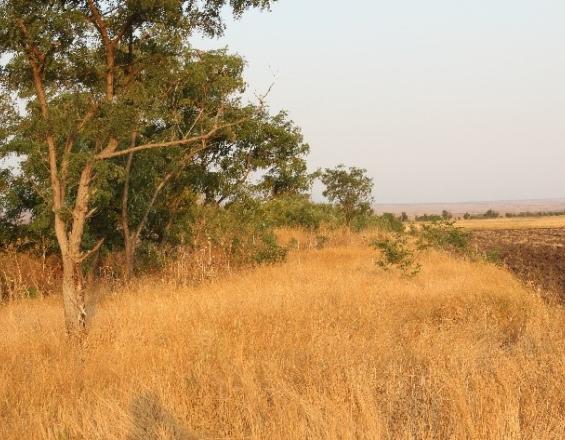
This example of best practice describes windbreaks as an integrated approach to increase land productivity and biodiversity at different levels. Windbreaks are a well-known measure against wind erosion. They consist of rows of trees and bushes along the edges of agricultural fields to protect the topsoil from strong winds. The approach was implemented in East Georgia between 2009 and 2019 as part of the “Sustainable Management of Biodiversity, South Caucasus” and the “Integrated Biodiversity Management, South Caucasus” programmes. In these projects, 11km long windbreaks were rehabilitated and newly established, with trees and shrubs planted 10m wide. The tree species included almond, China tree, Russian olive, pistachio, wild pear, wild apricots, black locust, common ash, Caucasian hackberry, Eldar pine and field elm. These species were planted according to the developed planting scheme, using soil and seedling preparation techniques.
Context
Challenges addressed
Windbreaks are an important way of adapting to dry climate conditions and protecting agricultural fields from wind and soil erosion. In the 1950s-70s, around 1,800 km of tree windbreaks were planted in Shiraki. More than 90% of them were destroyed either by fire or illegal cuttings for firewood. Fires are caused by farmers burning harvest residues and by shepherds burning pastures and windbreaks to facilitate the growth of new grass and clear land.
Drought, fire, and frost, but also browsing by (migrating) sheep and cattle, as well as illegal cutting for firewood comprised the main difficulties faced during the rehabilitation of windbreaks. Unclear institutional and managerial setup regarding mandates and obligations for maintaining the windbreak system further aggravate the situation.
Location
Process
Summary of the process
The approach described here covers a step by step instruction on rehabilitating or growing windbreaks. All building blocks, selection of the site and principle design, seedling selection, and maintenance and protection describe activities and requirements for windbreak rehabilitation. They include a sequence of activities, lessons learned and enabling factors for their successful implementation.
The 1st block begins with the design and preparation of the site for planting of selected drought-resistant bush and tree species. The design plan also specifies trees to be planted in the central and outer rows.
The 2nd block shows the selection of robust trees and bushes adapted to local climate conditions and their survival rate. These recommendations are based on field tests during the project implementation and proved their worth for the Shiraki valley. Irrigation and conditions for planting seedlings are also described in this block.
The 3rd block shows the results of the cost-benefit analysis and how a ban on burning can improve the protection of the remaining and newly established windbreaks. It includes next steps for further adaptation to windbreaks and conditions that support the sustainability of the approach in future.
Building Blocks
Selection of sites and principle design
The planting scheme should be adapted to the local site conditions as well as the location, length and width of the windbreaks. The windbreak may consist of three to four rows of different tree and shrub species with a total width of 10 m and a distance of 400-500 m between them. While the middle row consists of large trees (black locust, common ash, Caucasian hackberry, field elm), the outer rows, include smaller trees or shrubs (almond, China tree, Russian olive, pistachio, wild pear, wild apricots). The distance between trees and shrubs is 2-3 m with 2-3 m between the rows in chess order.
Enabling factors
The seedlings should be planted in autumn according to the well-designed plan as it is described in the graphic attached. This allows the root to rest for a while and enhances the chance for sufficient precipitation, rain and snow. The planting sites are prepared to ensure water flow. It is advisable to set protective tubes during the winter. They provide good protection against wind and animals with an increase of the survival rate by more than 70%.
Lesson learned
Intercropping of vegetables, such as onions and potatoes in windbreaks can bring good results and encourage people to maintain and protect windbreaks from fire.
Seedling selection
The windbreaks were replanted in Shiraki valley to combat wind erosion. Robust trees and bushes were identified during almost ten years of testing with a wide range of species. Local species that survived the humid and the extremely dry and hot years were selected for Shiraki. Local nurseries provided their seedlings (containerized). The list of species with a good survival rate in Shiraki are provided below:
Bushes for outer rows: Amygdalus communis, survival rate: 40-80%; Koelreuteria paniculata, survival rate: 50-90%; Elaeagnus angustifolia, survival rate: 35-70%; Pistacia mutica, survival rate: 70-90%; Pyrus caucasica, survival rate: up to 80%, Prunus armeniaca, survival rate: 65-75%.
Trees for central row: Robinia pseudoacacia, survival rate: 50-75%; Fraxinus excelsior, survival rate: 40-55%; Celtis australis subsp. caucasica (syn. Celtis caucasica), survival rate: 50-80%; Ulmus minor, survival rate: 50-80%.
Most of these trees and bushes are fruit-bearing, drought-tolerant and often planted to combat soil erosion in arid regions.
Young seedlings should be watered at least 2-4 times per year with 5-10 litres each within the first two years.
Enabling factors
Seeds are collected from larger rehabilitation areas (preferably from trees and bushes that had survived recent droughts) to ensure appropriate provenance and adaptation to the site-specific ecological conditions.
The seeds should be professionally prepared for planting in a nursery.
Lesson learned
The experiments with growing almonds and wild apricots by sowing were successful. Less successful but still recommendable was the growing of pistachio by sowing.
In case, seedlings are to be transported over long distances they should be grown in special containers to ensure good root system development and minimise transport damage. If they are grown close to the planting site and the transport time is short, seedlings may also be bare-rooted.
Experience shows that most plants are safe and completely self-sufficient after four years.
Maintenance and protection
GIZ conducted a cost-benefit analysis to assess the value of protecting remaining windbreaks, the benefits of straw as a fertiliser and the economic impact of a ban on burning crop residue. The survey data showed that a ban of crop residue burning would help to protect existing windbreaks. The shredding of straw during harvesting and the subsequent integration of straw into the soil builds up organic soil material and helps to store moisture in the soil. Enhancing the soil carbon content will increase the fertility of soil. Soil carbon content is an important indicator for monitoring land degradation neutrality (LDN).
Unclear ownership and institutional responsibility are the main obstacles to building sustainability in windbreaks. At the political level, a working group under the National Forest Programme chose restoration of windbreaks as a key topic. With the support of GIZ, the Ministry of Environmental Protection and Agriculture developed a policy for rehabilitation and protection of windbreaks. Buildings on this, a new law on windbreaks was initiated to clarify the situation by defining clear responsibilities for windbreak maintenance and management. As of today, the law is in the preparatory stage in the Agrarian Committee of the Georgian Parliament.
Enabling factors
To ensure the sustainability of the windbreak rehabilitation, these steps are important:
- Official approval of the new law on windbreaks
- Initiation and development of a state programme for the rehabilitation and protection of windbreaks to ensure a degree of self-sufficiency in wheat production (for national security)
- Introduction of alternatives to agricultural burning
- Raising awareness of the benefits and support of land users in the use of agricultural residues (e.g., for briquetting, as straw for stables)
Lesson learned
It is important to control fires as they easily spread across fields. Should farmers continue burning, the impact can hardly be effectively mitigated. A legally enforced ban on incineration, or crop residue burning, will better protect farmers from unforeseeable fires from neighbouring farms.
Impacts
Windbreaks protect the land from wind erosion and drought, help to increase crop yields and timber production. Windbreaks provide refuge areas for plant species sensitive to herbicides and ploughing, and shelter and breeding habitat for birds and small mammals, including predators of agricultural pests. Tree litter improves soil conditions and has a positive impact on the diversity of soil vertebrates and reduces wind velocity up to 200 m into arable land, resulting in a reduction in wind erosion of the topsoil which increases soil productivity. Also, windbreaks improve the microclimate for crops growing in their shelter by reducing moisture loss.
Restoration of windbreaks helps to protect the Shiraki valley from the transformation into steppes in the coming decades. In addition, windbreaks help to make land management more resilient to the effects of climate change.
Beneficiaries
The beneficiaries are households and farmers, as the windbreaks have a positive impact on crop and timber production. The local population and animals (birds, small mammals, insects) can benefit from the positive ecological and climatic impacts.
